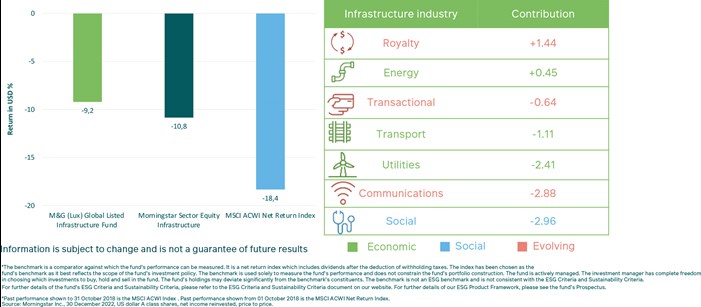Compelling reasons to add global listed infrastructure to a portfolio
South African investors have historically been underexposed to global listed infrastructure. However, changes to Regulation 28 of the Pension Funds Act could open the opportunity set for investors seeking to diversify into this unique asset class.
The definition of “infrastructure” published in January 2023 refers to: “assets with the main objective of developing, constructing, or maintaining physical assets and technology to provide utilities, services, or facilities to the benefit of the economy, business, or the public. It includes private sector developments as well as traditional public sector projects”. Furthermore, retirement funds are now allowed to invest in infrastructure, up to a total limit of 45% across all asset classes (excluding any debt issued by or guaranteed by the SA government).
“Listed infrastructure” is therefore buying shares in the listed companies that own or control strategic physical infrastructure assets with high dividend growth potential over the long term.
From a portfolio construction perspective, we share some of the compelling reasons for local investors to consider adding global listed infrastructure exposure to their asset allocation mix.
Protects on the downside
One of the key features of this asset class and strategy is its ability to preserve capital in difficult market conditions. Take a recent example in 2022 where the global equity market was down more than 18% in dollar terms, as shown in graph 1. However, the M&G (Lux) Global Listed Infrastructure Fund (USD) preserved nearly half of that capital (-9%). Here, the traditional utilities sector was instrumental in delivering that downside protection. Utilities are quite prominent in this portfolio at around 30%, which is lower than a typical infrastructure portfolio but still quite prominent in the context of the fund.
And when markets recover, the fund is positioned to benefit from that upside participation because of its growth focus and the wide opportunity set within the fund’s holdings.
Graph 1

Defensive in nature
Listed infrastructure companies demonstrate defensive qualities of protecting capital during market downturns. This is particularly true in the social infrastructure component, covering infrastructure providing health, education, and civic functions. The characteristics of this component tend to add defensive qualities and typically have a guaranteed revenue stream (most often coming from governments) for the infrastructure provided, with good dividend yield that tends to grow with inflation over time, regardless of market movements. In the M&G (Lux) Global Listed Infrastructure Fund (USD), this component has performed well in difficult market conditions. As an example, during the global pandemic, it was the best-performing part of the fund.
Provides a stable, growing income over the long term
Listed infrastructure investments tend to be geared to the longer term. Unlike private equity, listed infrastructure unit trusts offer far more liquidity and flexibility. The structural growth potential within the global listed infrastructure sector makes it increasingly appealing for those seeking stable and growing long-term income. As an example, the fund focuses on companies, such as utilities companies, that are consistently able to compound their earnings, cash flow and dividend growth because of the nature of their businesses and assets. This income growth and compounding over time therefore serve as an inflation buffer.
Adds layers of diversification
Infrastructure has a low correlation to traditional asset classes. It can also be viewed as complementary, or as an alternative to, global equity.
Within the listed infrastructure strategy employed at M&G, the broader definition of “infrastructure” (i.e. covering economic, social and evolving components) by its nature already adds layers of diversification. The underlying return constituents of each of the three categories of infrastructure tend to move in different ways in various market cycles, adding more layers of diversification. Furthermore, there is diversification across the categories, sectors, and subsectors, as well as geographic diversification due to it being a globally focused strategy.
Investing for real world impact
Investing in global listed infrastructure gives you an opportunity to invest for impact by contributing to the long-term socio-economic benefits of a country or region.
Through this strategy, you can invest in powerful long-term themes and multi-decade trends, such as renewable energy and energy security; transportation of the future, and universal connectivity, to name a few. We remain optimistic about the longer-term growth prospects for listed infrastructure driven by powerful structural trends, such as artificial intelligence and the global green energy transition and energy security.
A solid building block
Given the above reasons and its long-term nature, infrastructure can be considered as a good match with retirement savings. However, this relatively new asset class is poised to benefit from structural growth trends and headwinds turning into tailwinds, such as interest rates peaking globally and potential rate cuts expected, making it an appealing option for any long-term investment. For more information on the M&G Global Listed Infrastructure Fund (USD) and M&G Global Listed Infrastructure Feeder Fund (ZAR), visit www.mandg.co.za.
Share
Did you enjoy this article?
 South Africa
South Africa Namibia
Namibia




 Get the Newsletter
Get the Newsletter